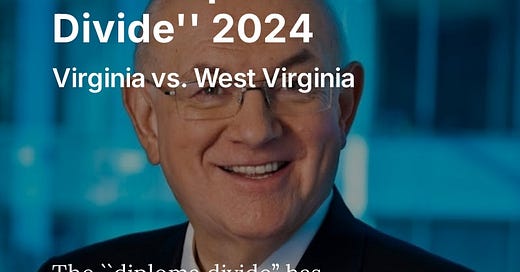The ``diploma divide’’ has become a key source of political polarization in the U.S. It’s not exactly new, but Donald Trump has made the diploma divide stronger than ever. According to the 2024 national exit poll, voters who never attended college voted 62 percent for Trump. Those with some college but no degree voted 53 percent for Trump. Four-year college degree? 53 percent for Kamala Harris. Advanced degree? 59 percent for Harris. Harris’s problem: only 43 percent of voters had at least a four-year college degree.
Among white voters, the effect was even stronger. White voters with a college degree: 45 percent for Trump. White voters with no degree: Trump beat Harris by better than two to one (66 to 32 percent). Even among whites, non-college voters outnumbered voters with a degree (54 to 46 percent).
The gap between college-educated and non-college voters has been growing since the civil rights and antiwar movements of the 1960s. Maybe even earlier. It was becoming apparent as early as the 1950s. The story, possibly apocryphal, is told of a voice calling out to Democratic presidential candidate Adlai Stevenson on the campaign trail in 1952 or 1956, ``Every thinking person in America will be voting for you!’’ Stevenson’s response? ``I’m afraid that won’t do. I need a majority!’’ Stevenson and his supporters were widely mocked by Republicans in the 1950s as ``eggheads’’ – meaning intellectuals.
The ten states with the highest percentages of college graduates (led by Massachusetts) all voted for Kamala Harris. Among the ten states with the lowest percentages of college graduates, all but one voted for Trump. The exception? New Mexico, the state with the highest percentage of Hispanics.
The state with the lowest percentage of college educated voters is – surprise! – not Mississippi, or even a southern state. It’s West Virginia, a state that’s 90 percent white and only 21 percent college educated.
You can see the realignment of U.S. politics by comparing the voting histories of West Virginia and (my home state) Virginia.
Virginia happens to be the only southern state that’s among the ten best educated states (it ranks seventh). That’s because of high levels of education among government workers in northern Virginia. I sometimes remark to my students at a Virginia public university that Virginia is two thirds southern and one third New Jersey.
I remember, from when I was growing up in Virginia in the 1950s, I had a keen interest in presidential politics. My teachers would often tell me that there was not much of a presidential campaign in Virginia because Virginia was a southern state and ``the South always votes Democratic.’’ Virginia was the site of ``massive resistance’’ to integration after the U.S. Supreme Court outlawed segregated public schools in 1954. (``Massive resistance’’ meant that some Virginia public schools temporarily shut down rather than integrate.)
Imagine my surprise when Virginia voted for a Republican, Dwight D. Eisenhower, not once but twice. Virginia actually used to be the most Republican southern state. It voted Republican in every presidential election from 1952 through 2004 except for 1964. Virginia was the only southern state that did not vote for Jimmy Carter in 1976.
At the same time, West Virginia used to be a strongly Democratic state. West Virginia is a heavily unionized coal mining state that rallied to the support of New Deal Democrats. West Virginia is the most Appalachian state in the country, and that means a population that is almost entirely working class whites.
Appalachian whites used to be called Scots-Irish. They were descended from Ulster Protestants (mostly Scottish Presbyterians) who faced discrimination from both Irish Catholics and Church of England Protestants. When they came to America, they became mountain dwellers (nicknamed ``hillbillies’’) and fierce fighters. Andrew Jackson, a slave owner, Indian fighter and military hero, was the first Scots-Irish President. President Donald Trump had Jackson’s portrait hung in the Oval Office.
Former U.S. Senator Jim Webb (D-Va.) wrote a book about his people entitled Born Fighting: How the Scots-Irish Shaped America. The current Vice President-elect, JD Vance, also Scots-Irish, wrote about ``Appalachian values’’ in his book, Hillbilly Elegy.
[For a hilarious – and occasionally moving – take on West Virginia culture, stream the 2017 film ``Logan Lucky’’ starring Daniel Craig and Adam Driver.]
West Virginia voted Democratic for President in 17 elections from 1932 to 1996 except for three Republican landslide years (1956, 1972 and 1984). The longest serving U.S. senator in history (51 years) was a West Virginia Democrat, former Senate Majority Leader Robert Byrd.
Then, in the 21st century, the great political realignment happened and Democrats began to lose the white working class. West Virginia has given Republicans an increasing majority of its presidential vote in the last seven presidential elections, starting with George W. Bush in 2000. In 2024, Trump lost well educated Virginia with 47 percent of the vote. White working class West Virginia gave Trump a whopping 70 percent (it was his second best state after Wyoming).
Virginia is no longer predictably Republican for president. But West Virginia – homeland of the United Mine Workers and labor radicals like Mary Harris ``Mother’’ Jones -- has now become just about the most reliably Republican state in the country. In 2025, West Virginia Democrats will hold no elected statewide offices, no congressional seats and minorities in both houses of the state legislature. That’s political realignment.




I liked the article.